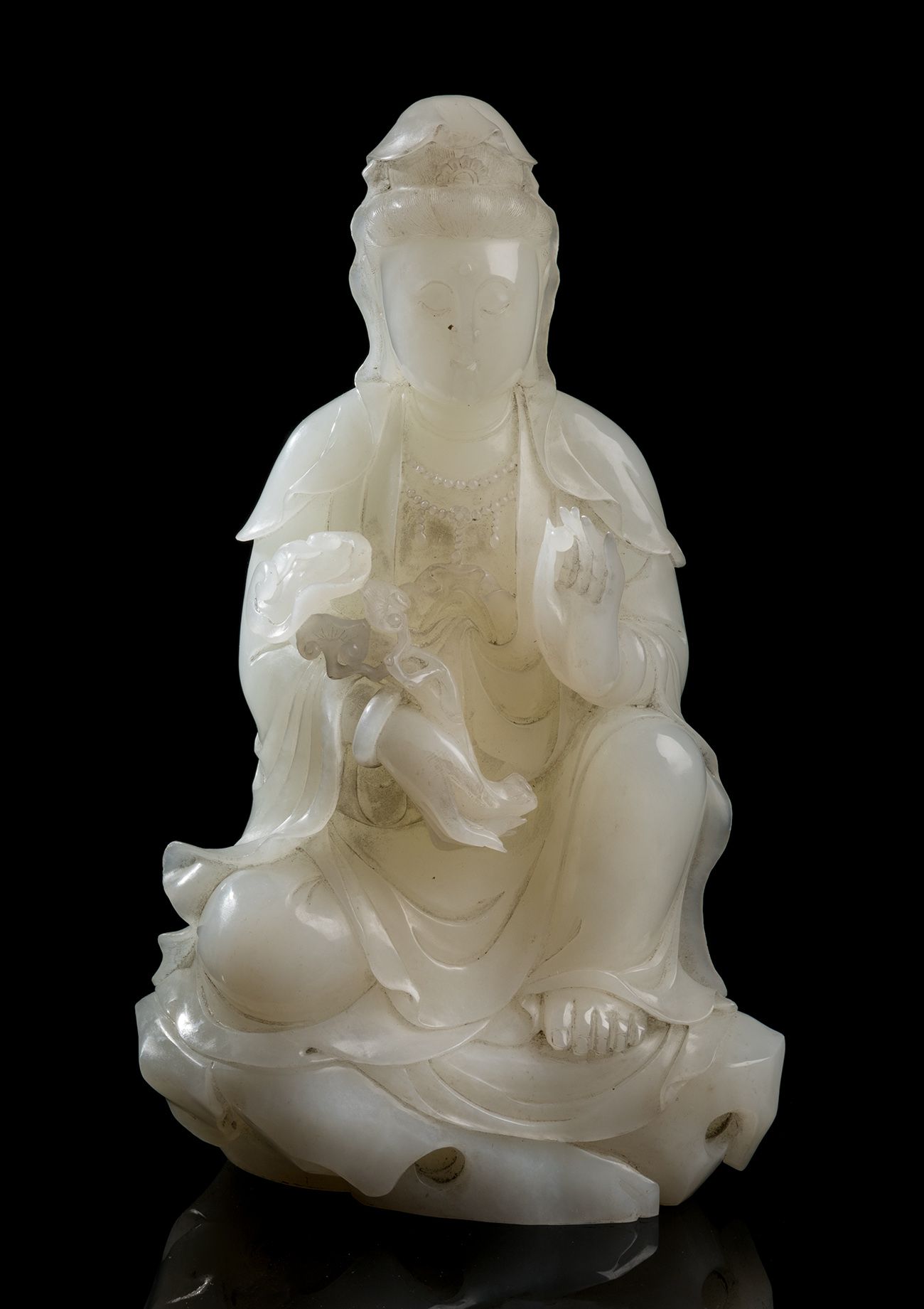Description
Guanyin; China, Quing Dynasty, 1644-1911. Carved white jade. Measurements: 23 x 14 x 6 cm. "Guanyin" is the Chinese name for the Avalokitevara bodhisattva divinity venerated in Buddhism. This bodhisattva is associated with compassion, and his name has the etymological root Guan Shì Yin, which means "he who hears the lamentations of the world". In popular belief, Guanyin is a protective, almost maternal divinity, who comes to the rescue of those who invoke her in times of great danger, and for this reason numerous shrines have been dedicated to her. In the West, this figure has been associated with that of the ancient mother goddesses of the primitive religions of the Mediterranean arc. In this case the figure is represented in a meditative attitude, seated with a subtle and elegant gesture accompanied by the delicate features of the face, carved on jade. This mineral has been used in China since the Neolithic period, at first worked by abrasion and later by carving. Since ancient times it has had a value equivalent to that given in Europe to gold, silver or precious stones. Since prehistoric times it has been the burial material par excellence in China, and it also conferred status, as it was the material used by the powerful. It was therefore a material that was believed to protect during life, which is why it was used to make amulets, ornaments and ritual knives. It is also associated with the five virtues: charity, because of its lustre, which shines but does not dazzle; righteousness, because of its transparency, which reveals the veins; wisdom, because of its purity and sound; courage, because it breaks but does not bend; and justice, because its sharp edges do not hurt. The Ching or Qing Dynasty, also known as the Manchu Dynasty, was the last of the Chinese imperial dynasties. Founded in what is now northeastern China by the Manchu clan in 1644, its rule ended with the abdication of the last Emperor in 1912 by the Xinhai Revolution and the establishment of the Republic of China, all the while maintaining the capital at Beijing. In general, traditional art forms flourished in many different and varied levels and formats, thanks to a highly educated upper class, a thriving publishing industry of books, pamphlets, etc., really prosperous cities and the Confucian emphasis on cultivating the mind. While the Emperors themselves were often outstanding artists (especially in painting), the best work was done by scholars and the urban elite in calligraphy and painting, both areas of great interest to the court. Even cuisine was elevated as a source of cultural pride in this period, taking elements from the past and working on them to reach new heights.
60
Guanyin; China, Quing Dynasty, 1644-1911. Carved white jade. Measurements: 23 x 14 x 6 cm. "Guanyin" is the Chinese name for the Avalokitevara bodhisattva divinity venerated in Buddhism. This bodhisattva is associated with compassion, and his name has the etymological root Guan Shì Yin, which means "he who hears the lamentations of the world". In popular belief, Guanyin is a protective, almost maternal divinity, who comes to the rescue of those who invoke her in times of great danger, and for this reason numerous shrines have been dedicated to her. In the West, this figure has been associated with that of the ancient mother goddesses of the primitive religions of the Mediterranean arc. In this case the figure is represented in a meditative attitude, seated with a subtle and elegant gesture accompanied by the delicate features of the face, carved on jade. This mineral has been used in China since the Neolithic period, at first worked by abrasion and later by carving. Since ancient times it has had a value equivalent to that given in Europe to gold, silver or precious stones. Since prehistoric times it has been the burial material par excellence in China, and it also conferred status, as it was the material used by the powerful. It was therefore a material that was believed to protect during life, which is why it was used to make amulets, ornaments and ritual knives. It is also associated with the five virtues: charity, because of its lustre, which shines but does not dazzle; righteousness, because of its transparency, which reveals the veins; wisdom, because of its purity and sound; courage, because it breaks but does not bend; and justice, because its sharp edges do not hurt. The Ching or Qing Dynasty, also known as the Manchu Dynasty, was the last of the Chinese imperial dynasties. Founded in what is now northeastern China by the Manchu clan in 1644, its rule ended with the abdication of the last Emperor in 1912 by the Xinhai Revolution and the establishment of the Republic of China, all the while maintaining the capital at Beijing. In general, traditional art forms flourished in many different and varied levels and formats, thanks to a highly educated upper class, a thriving publishing industry of books, pamphlets, etc., really prosperous cities and the Confucian emphasis on cultivating the mind. While the Emperors themselves were often outstanding artists (especially in painting), the best work was done by scholars and the urban elite in calligraphy and painting, both areas of great interest to the court. Even cuisine was elevated as a source of cultural pride in this period, taking elements from the past and working on them to reach new heights.
